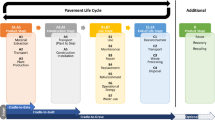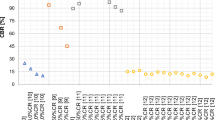Abstract
Pavement sustainability draws attention from different stakeholders in recent years. Warm mix asphalt (WMA) incorporating reclaimed asphalt pavement (RAP) or reclaimed asphalt shingles (RAS) has been widely recognized as a sustainable combo for pavement construction by conserving natural resources and reducing greenhouse gas emission. However, as their usage surges, little research has been conducted to date through a comprehensive laboratory and field evaluation to verify the performance of WMA incorporating RAP and RAS compared to traditional hot mix asphalt (HMA). In this research, five WMA sections with different WMA techniques and one control HMA section constructed in Oklahoma were continuously monitored for four years. The aggregate consensus, source, and gradation properties were tested in the laboratory. Mixture characteristics for lab-compacted samples including cracking resistance, rutting performance, moisture susceptibility, and water permeability were measured to compare WMA to HMA incorporating RAP and RAS. In addition, pavement surface conditions in terms of pavement cracking, rutting, roughness, texture, and friction were collected from the field site ten times in four years by using several state-of-the-art high-speed devices without traffic control. The laboratory and four-years field monitoring results demonstrate that WMA incorporating RAP and RAS accomplishes desired performance while providing sustainable benefits.
Similar content being viewed by others
References
AASHTO T 176-08 (2008) Standard method of test for plastic fines in graded aggregates and soils by use of the sand equivalent test. AASHTO T 176-08, American Association of State Highway and Transportation Officials, Washington DC, USA
AASHTO T 283-14 (2014) Standard method of test for resistance of compacted asphalt mixtures to moisture-induced damage. AASHTO T 283-14, American Association of State Highway and Transportation Officials, Washington DC, USA
Al-Qadi IL, Baek J, Leng Z, Wang H, Doyen M, Kern J, Gillen SL (2012) Short-term performance of modified stone matrix asphalt (SMA) produced with warm mix additives. Final Report ICT-12-001, Illinois Center for Transportation, Champaign, IL, USA
Arhin SA, Noel EC, Ribbiso A (2015) Acceptable international roughness index thresholds based on present serviceability rating. Journal of Civil Engineering Research 5(4):90–96
Arshadi A, Steger R, Ghabchi R, Zaman M, Hobson K, Commuri S (2017) Performance evaluation of plant-produced warm mix asphalts containing RAP and RAS. Road Materials and Pavement Design 18(4):293–310, DOI: https://doi.org/10.1080/14680629.2017.1389075
Aschenbrener T, Schiebel B, West R (2011) Three-year evaluation of the Colorado Department of Transportation’s warm mix asphalt experimental feature on I-70 at Silverthorne, Colorado. Colorado Department of Transportation, Denver, CO, USA
ASTM C131/C131M-14 (2014) Standard test method for resistance to degradation of small-size coarse aggregate by abrasion and impact in the Los Angeles machine. ASTM C131/C131M-14, ASTM International, West Conshohocken PA, USA, DOI: https://doi.org/10.1520/C0131_C0131M-14
ASTM D3042-09 (2015) Standard test method for insoluble residual in carbonate aggregates. ASTM D3042-09, ASTM International, West Conshohocken, PA, USA, DOI: https://doi.org/10.1520/D3042-09R15
ASTM D3744/D3744M-18 (2018) Standard test method for aggregate durability index. ASTM D3744/D3744M-18, ASTM International, West Conshohocken, PA, DOI: https://doi.org/10.1520/D3744_D3744M-18
ASTM D4791-10 (2010) Standard test method for flat particles, elongated particles, or flat and elongated particles in coarse aggregate. ASTM D4791-10, ASTM International, West Conshohocken, PA, USA, DOI: https://doi.org/10.1520/D4791-10
ASTM D5821-13 (2013) Standard test method for determining the percentage of fractured particles in coarse aggregate. ASTM D5821-13, ASTM International, West Conshohocken PA, USA, DOI: https://doi.org/10.1520/D5821-13
ASTM D6433-18 (2018) Standard practice for roads and parking lots pavement condition index surveys. ASTM D6433-18, ASTM International, West Conshohocken, PA, USA, DOI: https://doi.org/10.1520/D6433-18
ASTM D6928-17 (2017) Standard test method for resistance of coarse aggregate to degradation by abrasion in the Micro-Deval apparatus. ASTM D6928-17, ASTM International, West Conshohocken, PA, USA, DOI: https://doi.org/10.1520/D6928-17
ASTM D6931-17 (2017) Standard test method for indirect tensile (IDT) strength of asphalt mixtures. ASTM D6931-17, ASTM International, West Conshohocken, PA, USA, DOI: https://doi.org/10.1520/D6931-17
ASTM E2340/E2340M-11 (2015) Standard test method for measuring the skid resistance of pavements and other trafficked surfaces using a continuous reading, fixed-slip technique. ASTM E2340/E2340M-11, ASTM International, West Conshohocken, PA, USA
Awadalla M (2015) Field and laboratory investigation of asphalt pavement permeability. MSc Thesis, Carleton University, Ottawa, Canada
Bower N, Wen H, Wu S, Willoughby K, Weston J, DeVol J (2016) Evaluation of the performance of warm mix asphalt in Washington state. International Journal of Pavement Engineering 17(5):423–434, DOI: https://doi.org/10.1080/10298436.2014.993199
Buncher M (2016) What percentage of our roads are asphalt? The Magazine of The Asphalt Institute, Retrieved November 10, 2019, http://asphaltmagazine.com/94percent/
Cerezo V, Do M, Prevost D, Bouteldja M (2014) Friction/water depth relationship of in-situ observations and its integration in tire/road friction models. Journal of Engineering Tribology 228(11):1285–1297
Copeland A (2011) Reclaimed asphalt pavement in asphalt mixtures: State of the practice. FHWA-HRT-11-021, Federal Highway Administration, Mclean, VA, USA
Dave EV, Hanson CE, Helmer B, Dailey J, Hoplin CM (2015) Laboratory performance test for asphalt concrete. Publication MN/RC 2015-24, Minnesota Department of Transportation, St. Paul, MN, USA
FHWA (2001) Superpave mixture design guide. Federal Highway Administration, Washington DC, USA
FFHWA (2013) Experimental design and research plan experiment SPS-10 warm mix asphalt study. Federal Highway Administration, Washington DC, USA
FHWA (2016) Strategies for improving sustainability of asphalt pavements. Federal Highway Administration, Washington DC, USA
Gierhart D (2009) Warm mix asphalt — What is it and how can we benefit? Asphalt Institute, Retrieved November 20, 2019, https://www.pavementpreservation.org/wp-content/uploads/presentations/Warm%20Mix%20Asphalt%20(WMA)%20-%20What%20is%20it%20and%20how%20can%20we%20benefit.pdf
Guo N, You Z, Zhao Y, Tan Y, Diab A (2014) Laboratory performance of warm mix asphalt containing recycled asphalt mixtures. Construction and Building Materials 64:141–149, DOI: https://doi.org/10.1016/j.conbuildmat.2014.04.002
Lee J, Moon S-J, Im J, Yang S (2017) Evaluation of moisture susceptibility of asphalt mixtures using dynamic modulus. Journal of Testing and Evaluation 45(4):1280–1288, DOI: https://doi.org/10.1520/JTE20150136
NAPA (2002) Designing and constructing SMA mixtures — State-of-the-practice. National Asphalt Pavement Association, Lanham, MD, USA
NASEM (2014) Field performance of warm mix asphalt technologies. National Academies of Sciences, Engineering, and Medicine, Washington DC, USA, DOI: https://doi.org/10.17226/22272
NASEM (2017) Long-term field performance of warm mix asphalt technologies. National Academies of Sciences, Engineering, and Medicine, Washington DC, USA, DOI: https://doi.org/10.17226/24708
NASEM (2018) Using recycled asphalt shingles with warm mix asphalt technologies. National Academies of Sciences, Engineering, and Medicine, Washington DC, USA, DOI: https://doi.org/10.17226/25185
Nazzal MD, Holcombe E, Kim SS, Abbas A, Kaya S (2018) Nanoscale and macroscale characterization of the influence of RAP and RAS on cracking resistance of asphalt mixes. Journal of Materials in Civil Engineering 30(12):04018334, DOI: https://doi.org/10.1061/(ASCE)MT.1943-5533.0002551
OHD L-44 (2007) Method of test for measurement of water permeability of compacted paving mixtures. Oklahoma Department of Transportation, Oklahoma City, OK, USA
OHD L-55 (2014) Method of test for Hamburg rut testing for compacted hot-mix asphalt (HMA). Oklahoma Department of Transportation, Oklahoma City, OK, USA
Oner J, Sengoz B (2015) Utilization of recycled asphalt concrete with warm mix asphalt and cost-benefit analysis. PLoS ONE 10(1): e116180, DOI: https://doi.org/10.1371/journal.pone.0116180
Prowell BD, Hurley GC, Frank B (2012) Warm-mix asphalt: Best practices, 3rd edition. National Asphalt Pavement Association, Lanham, MD, USA
Rughooputh R, Beeharry R Qasrawi H (2018) Warm mix asphalt for better sustainability under tropical climate. International Journal of Pavement Engineering 21(1), DOI: https://doi.org/10.1080/10298436.2018.1435877
Shu X, Huang B, Shrum ED, Jia X (2012) Laboratory evaluation of moisture susceptibility of foamed warm mix asphalt containing high percentages of RAP. Construction and Building Materials 35:125–130, DOI: https://doi.org/10.1016/j.conbuildmat.2012.02.095
Vardanega PJ (2014) State of the art: Permeability of asphalt concrete. Journal of Materials in Civil Engineering 26(1):54–64, DOI: https://doi.org/10.1061/(ASCE)MT.1943-5533.0000748
Wang KCP, Li QJ, Yang G, Zhan Y, Qiu Y (2015) Network level pavement evaluation with 1 mm 3D survey system. Journal of Transportation Engineering (English Edition) 2(6):391–398
Williams RC, Prowell BD (1999) Comparison of laboratory wheel-tracking test results with WesTrack performance. Transportation Research Record 1681(1):121–128, DOI: https://doi.org/10.3141/1681-15
Williams BA, Willis JR, Ross TC (2018) Asphalt pavement industry survey on recycled materials and warm-mix asphalt usage: 2018. National Asphalt Pavement Association. Lanham, MD, USA
Yildirim Y, Stokoe II KH (2006) Analysis of Hamburg wheel tracking device results in relation to field performance. FHWA/TX-06/0-4185-5, Texas Department of Transportation, Austin, TX, USA
Zhang A, Wang KCP, Li B, Yang E, Dai X, Peng Y, Fei Y, Liu Y, Li JQ, Chen C (2017) Automated pixel-level pavement crack detection on 3D asphalt surfaces using a deep-learning network. Computer-Aided Civil and Infrastructure Engineering 32:805–819
Zhang A, Wang KCP, Yang E, Li JQ, Chen C, Qiu Y (2018) Pavement lane marking detection using matched filter. Measurement 130:105–117
Zhou F, Button JW, Epps J (2011) Best practice for using RAS in HMA. FHWA/TX-12/0-6614-1, Texas Department of Transportation, Austin, TX, USA
Acknowledgments
The research presented in the paper was funded under the research project SP&R 2115, “Long Term Pavement Performance (LTPP) Monitoring of Six LTPP SPS-10 Sections in Oklahoma with 3D Laser Imaging”, sponsored by the Oklahoma Department of Transportation (ODOT). The opinions expressed in the paper are those of the authors, who are responsible for the accuracy of the presented data herein and do not necessarily reflect the official policies of the sponsoring agencies. This paper does not constitute a standard, regulation, or specification.
Author information
Authors and Affiliations
Corresponding author
Rights and permissions
About this article
Cite this article
Yang, G., Wang, K., Li, J.Q. et al. Laboratory and Field Performance Evaluation of Warm Mix Asphalt Incorporating RAP and RAS. KSCE J Civ Eng 26, 107–119 (2022). https://doi.org/10.1007/s12205-021-2315-8
Received:
Revised:
Accepted:
Published:
Issue Date:
DOI: https://doi.org/10.1007/s12205-021-2315-8




